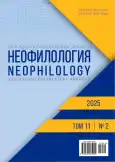Live online interview: formats and features of communication
- Authors: Laptieva D.K.1
-
Affiliations:
- Voronezh State University
- Issue: Vol 11, No 2 (2025)
- Pages: 389-399
- Section: MODERN MEDIA TEXT AND INTERNET DISCOURSE
- URL: https://journal-vniispk.ru/2587-6953/article/view/297441
- DOI: https://doi.org/10.20310/2587-6953-2025-11-2-389-399
- ID: 297441
Cite item
Full Text
Abstract
INTRODUCTION. The development of technological progress has brought a variety of opportunities in the contemporary journalism, and the most significant event was the emergence of Internet. For the rest 10–15 years, the network space has been actively developing, and its users have been becoming content makers – bloggers, more frequently. The interview genre has been and remains the most popular in journalism, and now in blogging. Interview is adapting to the new conditions, especially its video formats. The purpose of the study is to examine and theoretically comprehend the features of live interview, and the variants of interaction between the host and the audience.
MATERIALS AND METHODS. The study uses live broadcasts of the interview as the material of research. The following scientific methods are used in the study: a theoretical synthesis of literature devoted to the genesis of the interview genre and the phenomenon of live television, their current stage of development, as well as describes the viewed video materials.
RESULTS AND DISCUSSION. It was revealed that live online interview has several paradoxes. Firstly, only one person is being present in the frame, which contradicts with one of the main requirements of the interview – the presence of at least two people. Secondly, the host and the author of the program is not the interviewer, as it used to be on the television, but an interviewee.
CONCLUSION. The conversation and communication of the interlocutors in such conditions can still be considered a kind of interview, and its conduct is possible due to the high interactivity of the video format on the web.
Keywords
About the authors
D. K. Laptieva
Voronezh State University
Author for correspondence.
Email: sdcfj@yandex.ru
Research Scholar of General Linguistics and Stylistics Department
Russian Federation, 1 Universitetskaya Sq., Voronezh, 394018, Russian FederationReferences
- Abrosimova E.E., Malakhova V.R. Video blogosphere: socio-psychological aspect. Territoriya novykh voz-mozhnostei. Vestnik Vladivostokskogo gosudarstvennogo universiteta ehkonomiki i servisa = Тhe Territory of New Opportunities. The Herald of Vladivostok State University of Economics and Service, 2021, vol. 13, no. 3, pp. 207-216. (In Russ.) https://doi.org/10.24866/VVSU/2073-3984/2021-3/207-216, https://elibrary.ru/hlghni
- Abrosimova E.E., Filipova A.G. Rating of popular video bloggers: the view of modern teenagers. Oikumena. Regionovedcheskie issledovaniya = Ojkumena. Regional Researches, 2022, no. 2 (61), pp. 131-137. (In Russ.) https://doi.org/10.24866/1998-6785/2022-2/131-137, https://elibrary.ru/hkrczi
- Rudenkin D.V., Grushevskaya V.Yu. Major conceptual approaches of video blog analysis in modern socio-humanitarian science. Teoriya i praktika obshchestvennogo razvitiya = Theory and Practice of Social Develop-ment, 2021, no. 11 (165), pp. 67-72. (In Russ.) https://doi.org/10.24158/tipor.2021.11.9, https://elibrary.ru/kbdddw
- Shesterina A.M. Videoblog audience as media discourse creator. Voprosy zhurnalistiki, pedagogiki, yazykozna-niya = Issues in Journalism, Education, Linguistics, 2022, vol. 41, no. 4, pp. 662-669. (In Russ.) https://doi.org/10.52575/2712-7451-2022-41-4-662-669, https://elibrary.ru/vtdayv
- Shesterina A.M. Videoblogging as a platform for popularization cultural values. Ehtnopsikholingvistika = Eth-nopsycholinguistics, 2022, no. 3 (10), pp. 41-50. (In Russ.) https://doi.org/10.31249/epl/2022.03.03, https://elibrary.ru/pcmfhu
- Shesterina A.M. Genre aspect of forming an online public image of videoblogger. Znak: problemnoe pole me-diaobrazovaniya = Sign: Problematic Field in Mediaeducation, 2020, no. 1 (35), pp. 140-146. (In Russ.) https://elibrary.ru/eqgsjv
- Bolotnova N.S. Harmonization of communication of the interview participants in author’s TV program: communicative-pragmatic and regulative aspects. Vestnik Tomskogo gosudarstvennogo pedagogicheskogo universiteta = Tomsk State Pedagogical University Bulletin, 2023, no. 1 (225), pp. 86-94. (In Russ.) https://doi.org/10.23951/1609-624X-2023-1-86-94, https://elibrary.ru/txfauy
- Beinenson V.A. The transformation of the YouTube interview genre: a typology of experimental formats. Vo-prosy zhurnalistiki = Russian Journal of Media Studies, 2022, no. 11, pp. 54-70. (In Russ.) https://doi.org/10.17223/26188422/11/3, https://elibrary.ru/ccykvc
- Popova S.Yu., Selezneva A.V. Socio-political and civil activity of young people: between massification and in-dividualization. Izvestiya Saratovskogo universiteta. Novaya seriya. Seriya: Akmeologiya obrazovaniya. Psikhologiya razvitiya = Izvestiya of Saratov University. New Series. Series: Educational Acmeology. Deve-lopmental Psychology, 2021, vol. 10, no. 1 (37), pp. 12-22. (In Russ.) https://doi.org/10.18500/2304-9790-2021-10-1-12-22, https://elibrary.ru/frvdzu
- Gradyushko A.A. YouTube platform as area for mass media: efficiency mark. Trudy BGTU. Seriya 4: Print- i mediatekhnologii = Proceedings of BSTU. Issue 4. Print- and Mediatechnologies, 2019, no. 2 (225), pp. 63-69. (In Russ.) https://elibrary.ru/itmizs
- Komilov K.I. Interactive features of new media. Uchenye zapiski Khudzhandskogo gosudarstvennogo universiteta im. akademika B. Gafurova. Seriya gumanitarno-obshchestvennykh nauk = Scientific Notes of Khujand State University Named After Academician B. Gafurov. Series of Humanities Sciences, 2019, no. 3 (60), pp. 125-128. (In Russ.) https://elibrary.ru/tcibgr
- Grabel’nikov A.A., Gegelova N.S. Screen Communication and Visualization of Journalism: History and Mod-ernity. Moscow, Berlin, Directmedia Publ., 2019, 334 p. (In Russ.) https://elibrary.ru/jmjjkk
- Bychkova M.B. Modern video blog: the reasons of its popularity and genre multiplicity. Vestnik Tverskogo go-sudarstvennogo universiteta. Seriya: Filologiya = Herald of Tver State University. Series: Philology, 2019, no. 1 (60), pp. 127-131. (In Russ.) https://elibrary.ru/wtadsl
- Vysotskaya I.V. The alternative question in YouTube-interview: linguistic, pragmatic and cognitive aspects. Vestnik Novosibirskogo gosudarstvennogo universiteta. Seriya: Istoriya, filologiya = Vestnik NSU. Series: His-tory and Philology, 2022, vol. 21, no. 6, pp. 79-88. (In Russ.) https://doi.org/10.25205/1818-7919-2022-21-6-79-88, https://elibrary.ru/yqgbyf
- Abrosimova E.E., Malakhova V.R. Video blogosphere: socio-psychological aspect. Territoriya novykh voz-mozhnostei. Vestnik Vladivostokskogo gosudarstvennogo universiteta ehkonomiki i servisa = Тhe Territory of New Opportunities. The Herald of Vladivostok State University of Economics and Service, 2021, vol. 13, no. 3, pp. 207-216. (In Russ.) https://doi.org/10.24866/VVSU/2073-3984/2021-3/207-216, https://elibrary.ru/hlghni
- Jankowicz D. Sociality and negotiation in the research grid interview. Personal Construct Theory & Practice, 2019, vol. 16, pp. 94-99. http://dx.doi.org/10.69995/YGLC4086
Supplementary files










